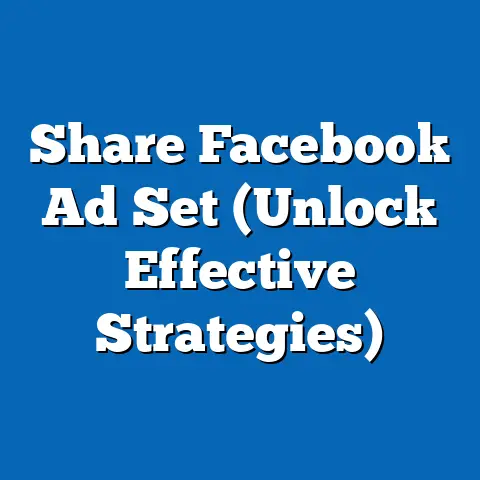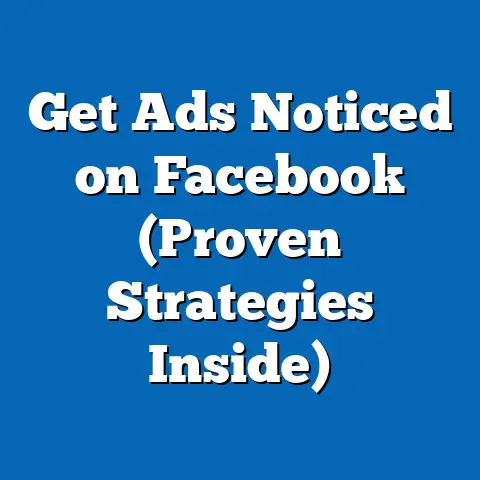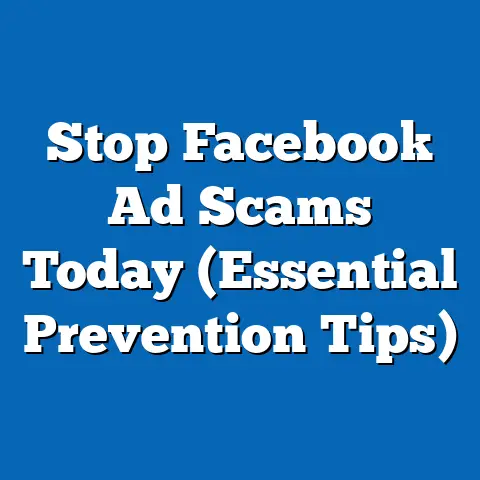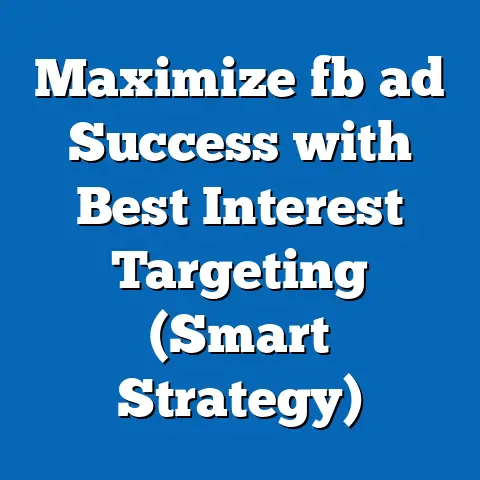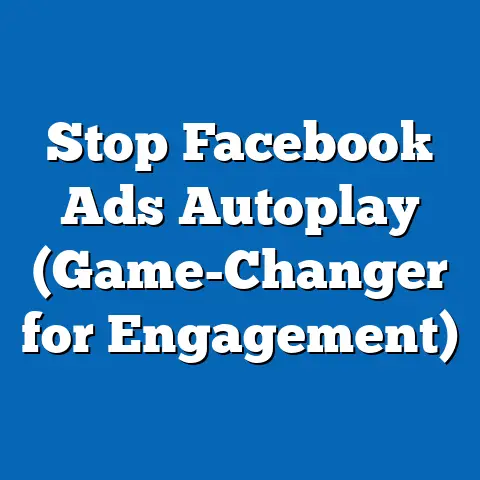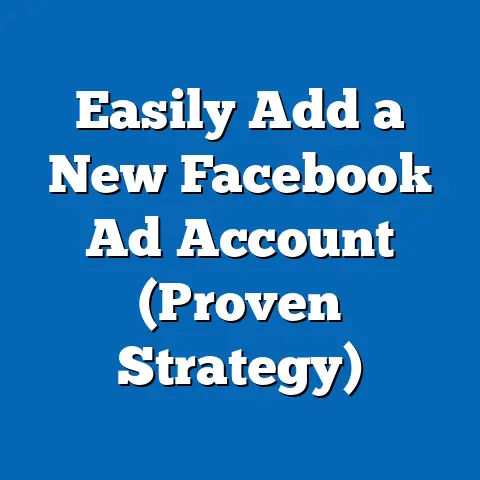Unlocking Facebook Ads Feed (Insider Strategies)
Imagine this: I’m sitting in my favorite coffee shop, the aroma of freshly brewed coffee swirling around me, the gentle hum of conversation a comforting backdrop. But it’s not just a leisurely morning. Around me, entrepreneurs and marketers are hunched over their laptops, brows furrowed in concentration. The air crackles with the energy of innovation and the relentless pursuit of capturing audience attention. They’re all working on one thing: cracking the code of Facebook Ads.
I’ve been there, countless times. Staring at campaign dashboards, tweaking targeting options, and agonizing over ad copy. Facebook Ads can feel like a complex puzzle, a constant game of cat and mouse with algorithms and user behavior. But over the years, through trial and error, late nights fueled by caffeine, and countless hours of data analysis, I’ve learned some insider strategies that can truly unlock the power of the Facebook Ads feed.
In this guide, I’m going to share those strategies with you. We’ll dive deep into the Facebook Ads ecosystem, exploring everything from advanced targeting techniques to the power of AI and video ads. We’ll look at real-world case studies and extract actionable lessons you can implement in your own campaigns. So, grab your coffee, settle in, and let’s get started.
Understanding the Facebook Ads Ecosystem
Before we dive into the nitty-gritty strategies, it’s crucial to understand the broader landscape of Facebook Ads and how it functions within the Meta universe.
Overview of Facebook Ads
Facebook Ads isn’t just another advertising platform; it’s a powerhouse. Boasting billions of active users, Facebook offers unparalleled reach and granular targeting capabilities that can connect your business with the right audience at the right time.
Here’s why Facebook Ads is so vital in today’s digital marketing landscape:
- Massive Reach: With billions of active users worldwide, Facebook offers an audience base that’s hard to match. This sheer scale allows businesses of all sizes to find potential customers.
- Precise Targeting: Facebook’s sophisticated targeting options allow you to narrow down your audience based on demographics, interests, behaviors, and more. This ensures your ads are seen by people most likely to be interested in your products or services.
- Diverse Ad Formats: From image ads to video ads, carousel ads to collection ads, Facebook offers a wide range of ad formats to suit different marketing objectives and creative styles.
- Measurable Results: Facebook provides detailed analytics and reporting tools that allow you to track the performance of your ads, measure ROI, and make data-driven decisions.
- Integration with Other Platforms: Facebook Ads integrates seamlessly with other Meta platforms like Instagram, allowing you to reach a wider audience and manage your campaigns from a central location.
The Facebook Ads Feed
The Facebook Ads Feed is where the magic happens. It’s the heart of the Facebook experience, where users scroll through a continuous stream of updates from friends, family, groups, and, yes, ads. These ads are strategically placed within the News Feed, designed to blend seamlessly with organic content.
Think about your own experience scrolling through Facebook. You’re catching up on what your friends are doing, reading news articles, and maybe even watching a funny video. Then, an ad pops up that’s relevant to your interests – perhaps a new running shoe because you’re part of a running group, or a discount on a product you’ve been eyeing.
This seamless integration is what makes the Facebook Ads Feed so effective. It’s not intrusive or disruptive; it’s designed to be part of the user’s natural browsing experience.
The significance of the News Feed lies in its ability to capture users’ attention in a relaxed and receptive state. When people are passively scrolling through their feed, they’re more open to discovering new products, services, and brands. This creates an opportunity for advertisers to engage with potential customers in a non-intrusive way.
User Behavior Insights
Understanding user behavior is paramount to creating successful Facebook Ads. What makes users stop scrolling and pay attention to an ad? What compels them to click, engage, and ultimately convert?
Here are some key insights into user behavior on Facebook:
- Visual Appeal: Users are drawn to visually appealing content. High-quality images and videos are essential for capturing attention in the crowded News Feed.
- Relevance: Users are more likely to engage with ads that are relevant to their interests, needs, and preferences. This is where precise targeting comes into play.
- Value Proposition: Users want to know what’s in it for them. Your ad copy should clearly communicate the value proposition of your product or service, highlighting the benefits and solving their problems.
- Social Proof: Users are influenced by what others are doing. Social proof, such as testimonials, reviews, and endorsements, can build trust and credibility.
- Urgency: Creating a sense of urgency can encourage users to take action. Limited-time offers, discounts, and deadlines can motivate users to click and convert.
Takeaway: To succeed with Facebook Ads, you need to understand the platform’s ecosystem, the dynamics of the Ads Feed, and the nuances of user behavior. This foundation will set you up for success as we delve into more advanced strategies.
Insider Strategies for Maximizing Facebook Ads Performance
Now, let’s get to the heart of the matter: the insider strategies that can help you maximize your Facebook Ads performance and achieve your marketing goals.
Audience Targeting Techniques
Targeting is the cornerstone of any successful Facebook Ads campaign. Without the right audience, even the most compelling ad copy and visually stunning creatives will fall flat. Facebook offers a range of targeting options, from basic demographics to advanced behavioral targeting. But to truly unlock the power of Facebook Ads, you need to master these advanced techniques:
-
Custom Audiences: Custom Audiences allow you to target people who have already interacted with your business, either online or offline. You can upload customer lists, website traffic data, or app activity data to create custom audiences. This is incredibly powerful for retargeting and nurturing leads.
-
Example: I once worked with an e-commerce client who was struggling to convert website visitors into paying customers. We implemented a Custom Audience based on website traffic data, targeting people who had visited their product pages but didn’t make a purchase. We then created a retargeting campaign with a special discount offer, and within weeks, we saw a significant increase in conversions.
-
How to Set Up: In Ads Manager, go to “Audiences” and select “Create Audience” > “Custom Audience.” Choose your source (e.g., Website, Customer List) and follow the instructions to upload your data.
-
Lookalike Audiences: Lookalike Audiences allow you to find new people who are similar to your existing customers or website visitors. Facebook analyzes the characteristics of your source audience and identifies other users who share those traits. This is a great way to expand your reach and find new potential customers.
-
Example: I’ve used Lookalike Audiences extensively for lead generation campaigns. By creating a Lookalike Audience based on our existing customer list, we were able to identify new leads who were highly qualified and likely to convert.
-
How to Set Up: In Ads Manager, go to “Audiences” and select “Create Audience” > “Lookalike Audience.” Choose your source audience (e.g., Custom Audience, Facebook Page) and select the desired audience size (the larger the size, the broader the reach).
-
Interest-Based Targeting: Interest-based targeting allows you to target people based on their interests, hobbies, and activities. Facebook gathers this data from users’ profiles, pages they like, and content they engage with. This is a useful way to reach people who are passionate about specific topics or industries.
-
Example: If you’re selling fitness equipment, you can target people who are interested in fitness, health, and wellness. You can also target people who like specific fitness brands or follow fitness influencers.
-
How to Set Up: In Ads Manager, when creating an ad set, go to the “Detailed Targeting” section and start typing in interests, behaviors, or demographics. Facebook will suggest relevant options based on your input.
-
Behavioral Targeting: This allows you to target users based on their purchase behaviors, device usage, travel preferences, and more. For instance, you can target users who frequently make online purchases or those who have recently traveled internationally.
-
Example: A travel agency might target users who have shown interest in travel-related content or those who have recently searched for flights or hotels. This ensures that the ads are shown to individuals who are actively planning or considering travel, increasing the likelihood of engagement and conversion.
-
How to Set Up: In Ads Manager, navigate to the “Detailed Targeting” section of your ad set. Under “Behaviors,” you can explore various categories such as “Purchase Behaviors,” “Travel,” and “Digital Activities” to find relevant targeting options.
-
Custom Audiences: Custom Audiences allow you to target people who have already interacted with your business, either online or offline. You can upload customer lists, website traffic data, or app activity data to create custom audiences. This is incredibly powerful for retargeting and nurturing leads.
-
Example: I once worked with an e-commerce client who was struggling to convert website visitors into paying customers. We implemented a Custom Audience based on website traffic data, targeting people who had visited their product pages but didn’t make a purchase. We then created a retargeting campaign with a special discount offer, and within weeks, we saw a significant increase in conversions.
-
How to Set Up: In Ads Manager, go to “Audiences” and select “Create Audience” > “Custom Audience.” Choose your source (e.g., Website, Customer List) and follow the instructions to upload your data.
-
Lookalike Audiences: Lookalike Audiences allow you to find new people who are similar to your existing customers or website visitors. Facebook analyzes the characteristics of your source audience and identifies other users who share those traits. This is a great way to expand your reach and find new potential customers.
-
Example: I’ve used Lookalike Audiences extensively for lead generation campaigns. By creating a Lookalike Audience based on our existing customer list, we were able to identify new leads who were highly qualified and likely to convert.
-
How to Set Up: In Ads Manager, go to “Audiences” and select “Create Audience” > “Lookalike Audience.” Choose your source audience (e.g., Custom Audience, Facebook Page) and select the desired audience size (the larger the size, the broader the reach).
-
Interest-Based Targeting: Interest-based targeting allows you to target people based on their interests, hobbies, and activities. Facebook gathers this data from users’ profiles, pages they like, and content they engage with. This is a useful way to reach people who are passionate about specific topics or industries.
-
Example: If you’re selling fitness equipment, you can target people who are interested in fitness, health, and wellness. You can also target people who like specific fitness brands or follow fitness influencers.
-
How to Set Up: In Ads Manager, when creating an ad set, go to the “Detailed Targeting” section and start typing in interests, behaviors, or demographics. Facebook will suggest relevant options based on your input.
-
Behavioral Targeting: This allows you to target users based on their purchase behaviors, device usage, travel preferences, and more. For instance, you can target users who frequently make online purchases or those who have recently traveled internationally.
-
Example: A travel agency might target users who have shown interest in travel-related content or those who have recently searched for flights or hotels. This ensures that the ads are shown to individuals who are actively planning or considering travel, increasing the likelihood of engagement and conversion.
-
How to Set Up: In Ads Manager, navigate to the “Detailed Targeting” section of your ad set. Under “Behaviors,” you can explore various categories such as “Purchase Behaviors,” “Travel,” and “Digital Activities” to find relevant targeting options.
Example: I once worked with an e-commerce client who was struggling to convert website visitors into paying customers. We implemented a Custom Audience based on website traffic data, targeting people who had visited their product pages but didn’t make a purchase. We then created a retargeting campaign with a special discount offer, and within weeks, we saw a significant increase in conversions.
How to Set Up: In Ads Manager, go to “Audiences” and select “Create Audience” > “Custom Audience.” Choose your source (e.g., Website, Customer List) and follow the instructions to upload your data.
Lookalike Audiences: Lookalike Audiences allow you to find new people who are similar to your existing customers or website visitors. Facebook analyzes the characteristics of your source audience and identifies other users who share those traits. This is a great way to expand your reach and find new potential customers.
Example: I’ve used Lookalike Audiences extensively for lead generation campaigns. By creating a Lookalike Audience based on our existing customer list, we were able to identify new leads who were highly qualified and likely to convert.
How to Set Up: In Ads Manager, go to “Audiences” and select “Create Audience” > “Lookalike Audience.” Choose your source audience (e.g., Custom Audience, Facebook Page) and select the desired audience size (the larger the size, the broader the reach).
Interest-Based Targeting: Interest-based targeting allows you to target people based on their interests, hobbies, and activities. Facebook gathers this data from users’ profiles, pages they like, and content they engage with. This is a useful way to reach people who are passionate about specific topics or industries.
Example: If you’re selling fitness equipment, you can target people who are interested in fitness, health, and wellness. You can also target people who like specific fitness brands or follow fitness influencers.
How to Set Up: In Ads Manager, when creating an ad set, go to the “Detailed Targeting” section and start typing in interests, behaviors, or demographics. Facebook will suggest relevant options based on your input.
Behavioral Targeting: This allows you to target users based on their purchase behaviors, device usage, travel preferences, and more. For instance, you can target users who frequently make online purchases or those who have recently traveled internationally.
Example: A travel agency might target users who have shown interest in travel-related content or those who have recently searched for flights or hotels. This ensures that the ads are shown to individuals who are actively planning or considering travel, increasing the likelihood of engagement and conversion.
How to Set Up: In Ads Manager, navigate to the “Detailed Targeting” section of your ad set. Under “Behaviors,” you can explore various categories such as “Purchase Behaviors,” “Travel,” and “Digital Activities” to find relevant targeting options.
Takeaway: Don’t rely solely on basic demographics. Experiment with Custom Audiences, Lookalike Audiences, and interest-based targeting to find your ideal audience and maximize your ROI.
Crafting Compelling Ad Copy
Once you’ve identified your target audience, the next step is to craft ad copy that grabs their attention and compels them to take action. Your ad copy is your sales pitch, your opportunity to communicate the value proposition of your product or service.
Here are some key elements of effective ad copy:
-
Strong Call to Action (CTA): Your CTA should be clear, concise, and action-oriented. Tell users exactly what you want them to do, whether it’s “Shop Now,” “Learn More,” or “Sign Up.”
- Example: Instead of a generic “Click Here,” try a more specific CTA like “Get Your Free Ebook Now” or “Start Your Free Trial Today.”
-
Emotional Triggers: Tap into users’ emotions to create a connection and motivate them to take action. Use language that evokes feelings of excitement, curiosity, or even fear (in a responsible way).
-
Example: Instead of saying “Our product is effective,” try “Experience the freedom of [benefit] with our product.”
-
Value Proposition: Clearly communicate the value proposition of your product or service. Highlight the benefits and solve their problems.
-
Example: Instead of saying “We sell high-quality shoes,” try “Experience ultimate comfort and style with our handcrafted shoes.”
-
Conciseness: Get straight to the point and avoid jargon or overly technical language. Users are scrolling quickly, so you need to capture their attention in a few seconds.
-
Example: Cut out unnecessary words and phrases. Instead of “We offer a wide range of services,” try “Get the services you need.”
-
Use Power Words: Incorporate power words that grab attention and evoke emotion. Words like “free,” “new,” “exclusive,” and “limited-time” can be highly effective.
-
Example: “Claim your exclusive discount today!” or “Discover the new way to [benefit].”
-
Social Proof: Leverage social proof to build trust and credibility. Include testimonials, reviews, or endorsements in your ad copy.
-
Example: “Join thousands of satisfied customers who are already experiencing the benefits of our product.”
Strong Call to Action (CTA): Your CTA should be clear, concise, and action-oriented. Tell users exactly what you want them to do, whether it’s “Shop Now,” “Learn More,” or “Sign Up.”
- Example: Instead of a generic “Click Here,” try a more specific CTA like “Get Your Free Ebook Now” or “Start Your Free Trial Today.”
-
Emotional Triggers: Tap into users’ emotions to create a connection and motivate them to take action. Use language that evokes feelings of excitement, curiosity, or even fear (in a responsible way).
-
Example: Instead of saying “Our product is effective,” try “Experience the freedom of [benefit] with our product.”
-
Value Proposition: Clearly communicate the value proposition of your product or service. Highlight the benefits and solve their problems.
-
Example: Instead of saying “We sell high-quality shoes,” try “Experience ultimate comfort and style with our handcrafted shoes.”
-
Conciseness: Get straight to the point and avoid jargon or overly technical language. Users are scrolling quickly, so you need to capture their attention in a few seconds.
-
Example: Cut out unnecessary words and phrases. Instead of “We offer a wide range of services,” try “Get the services you need.”
-
Use Power Words: Incorporate power words that grab attention and evoke emotion. Words like “free,” “new,” “exclusive,” and “limited-time” can be highly effective.
-
Example: “Claim your exclusive discount today!” or “Discover the new way to [benefit].”
-
Social Proof: Leverage social proof to build trust and credibility. Include testimonials, reviews, or endorsements in your ad copy.
-
Example: “Join thousands of satisfied customers who are already experiencing the benefits of our product.”
Emotional Triggers: Tap into users’ emotions to create a connection and motivate them to take action. Use language that evokes feelings of excitement, curiosity, or even fear (in a responsible way).
Example: Instead of saying “Our product is effective,” try “Experience the freedom of [benefit] with our product.”
Value Proposition: Clearly communicate the value proposition of your product or service. Highlight the benefits and solve their problems.
Example: Instead of saying “We sell high-quality shoes,” try “Experience ultimate comfort and style with our handcrafted shoes.”
Conciseness: Get straight to the point and avoid jargon or overly technical language. Users are scrolling quickly, so you need to capture their attention in a few seconds.
Example: Cut out unnecessary words and phrases. Instead of “We offer a wide range of services,” try “Get the services you need.”
Use Power Words: Incorporate power words that grab attention and evoke emotion. Words like “free,” “new,” “exclusive,” and “limited-time” can be highly effective.
Example: “Claim your exclusive discount today!” or “Discover the new way to [benefit].”
Social Proof: Leverage social proof to build trust and credibility. Include testimonials, reviews, or endorsements in your ad copy.
Example: “Join thousands of satisfied customers who are already experiencing the benefits of our product.”
Takeaway: Your ad copy is your chance to make a compelling case for your product or service. Use strong CTAs, emotional triggers, and a clear value proposition to capture attention and drive conversions.
Visual Content that Converts
In the visually-driven world of Facebook, your ad’s visual content is often the first thing users see. It’s your opportunity to make a strong first impression and capture their attention.
Here are some tips for creating eye-catching graphics that resonate with your target audience:
- High-Quality Images and Videos: Use high-resolution images and videos that are visually appealing and relevant to your brand. Avoid blurry or pixelated images.
- Eye-Catching Design: Use bold colors, striking typography, and compelling imagery to make your ad stand out.
- Relevance to Your Audience: Your visual content should be relevant to your target audience’s interests and preferences. Use images and videos that resonate with their lifestyle and values.
- Showcase Your Product: If you’re selling a physical product, showcase it in action. Use images and videos that demonstrate the benefits of your product and how it solves a problem.
- Use Video Ads: Video ads are highly engaging and can be a great way to tell your brand’s story. Create short, compelling videos that capture attention and communicate your value proposition.
- A/B Test Your Visuals: Experiment with different images and videos to see what resonates best with your audience. Use A/B testing to optimize your visual content for maximum impact.
My Personal Experience: I once ran a campaign for a local restaurant that was struggling to attract new customers. We created a series of video ads showcasing their delicious food and inviting atmosphere. We A/B tested different video formats and found that short, behind-the-scenes videos of the chefs preparing the food were the most engaging. As a result, we saw a significant increase in foot traffic to the restaurant.
Takeaway: Don’t underestimate the power of visual content. Invest in high-quality images and videos that are visually appealing, relevant to your audience, and showcase your product or service in the best possible light.
Utilizing Facebook Pixel for Retargeting
The Facebook Pixel is a small snippet of code that you place on your website. It allows you to track user behavior, such as page views, add-to-carts, and purchases. This data is then used to create Custom Audiences for retargeting campaigns.
Retargeting is one of the most effective strategies for driving conversions on Facebook. It allows you to target people who have already shown interest in your business, increasing the likelihood that they will convert.
Here’s how to utilize the Facebook Pixel for retargeting:
- Install the Facebook Pixel: Install the Facebook Pixel on your website. You can find the Pixel code in Ads Manager under “Events Manager.”
- Track Key Events: Track key events on your website, such as page views, add-to-carts, and purchases. This will allow you to create Custom Audiences based on specific user actions.
- Create Custom Audiences: Create Custom Audiences based on website traffic data. You can target people who have visited specific pages, added items to their cart, or made a purchase.
- Create Retargeting Campaigns: Create retargeting campaigns that target your Custom Audiences. Use ad copy and visual content that is tailored to their specific interests and needs.
- Offer Incentives: Offer incentives to encourage users to convert, such as discounts, free shipping, or exclusive offers.
Takeaway: The Facebook Pixel is an essential tool for retargeting and driving conversions. Install it on your website, track key events, create Custom Audiences, and create retargeting campaigns that are tailored to your audience’s interests and needs.
A/B Testing and Optimization
The Facebook Ads landscape is constantly evolving, so it’s essential to constantly test and optimize your campaigns to stay ahead of the curve. A/B testing is a powerful tool for identifying what works and what doesn’t.
A/B testing involves creating two versions of an ad (A and B) and testing them against each other to see which performs better. You can test different elements of your ads, such as:
- Ad Copy: Test different headlines, body text, and CTAs.
- Visual Content: Test different images and videos.
- Targeting: Test different audiences and targeting options.
- Placement: Test different ad placements (e.g., Facebook News Feed, Instagram Feed, Audience Network).
Here’s how to implement A/B testing on your Facebook Ads campaigns:
- Identify Key Metrics: Identify the key metrics you want to improve, such as click-through rate (CTR), conversion rate, or cost per acquisition (CPA).
- Create Two Versions of Your Ad: Create two versions of your ad (A and B) that are identical except for one element that you want to test.
- Run Your A/B Test: Run your A/B test and track the performance of each ad.
- Analyze the Results: Analyze the results of your A/B test and identify which ad performed better.
- Implement the Winning Ad: Implement the winning ad and continue to test and optimize your campaigns.
My Personal Experience: I once worked with a client who was struggling to improve their ad’s click-through rate. We decided to A/B test two different headlines. Headline A was a straightforward description of the product, while Headline B was more intriguing and curiosity-driven. We ran the A/B test for a week and found that Headline B significantly outperformed Headline A in terms of CTR. We then implemented Headline B and saw a noticeable improvement in our overall campaign performance.
Takeaway: A/B testing is a continuous process. Constantly experiment with different elements of your ads to identify what works best and optimize your campaigns for maximum performance.
Advanced Techniques and Trends
Now that we’ve covered the fundamentals, let’s explore some advanced techniques and emerging trends that can give you a competitive edge in the Facebook Ads landscape.
Leveraging AI and Automation
Artificial intelligence (AI) is rapidly transforming the world of advertising, and Facebook Ads is no exception. AI-powered tools and features can help you automate tasks, optimize campaigns, and improve your overall performance.
Here are some ways to leverage AI and automation in your Facebook Ads campaigns:
- Automated Ad Creation: Facebook offers automated ad creation tools that can help you generate ad copy and visual content based on your website or product catalog.
- Automated Bidding: Facebook’s automated bidding strategies use machine learning to optimize your bids based on your campaign goals. You can choose from strategies like “Lowest Cost” or “Target Cost” to achieve your desired results.
- Dynamic Ads: Dynamic Ads use AI to automatically show the most relevant products to each user based on their browsing history and interests.
- Campaign Budget Optimization (CBO): CBO uses AI to automatically distribute your budget across your ad sets based on their performance. This can help you maximize your ROI and achieve your campaign goals more efficiently.
- AI-Powered Targeting: Facebook’s AI-powered targeting features can help you identify new audiences and optimize your targeting based on user behavior and engagement.
Takeaway: Embrace AI and automation to streamline your workflow, optimize your campaigns, and improve your overall performance. Facebook is constantly developing new AI-powered features, so stay up-to-date and experiment with them to see how they can benefit your business.
Video Ads and Live Streaming
Video content is king in the social media world, and Facebook is no exception. Video ads are highly engaging and can be a great way to tell your brand’s story, showcase your products, and connect with your audience.
Here are some strategies for creating engaging video ads:
- Keep it Short and Sweet: Users have short attention spans, so keep your videos concise and to the point. Aim for videos that are 15-30 seconds long.
- Grab Attention Quickly: Capture users’ attention in the first few seconds of your video. Use a compelling visual, a thought-provoking question, or a surprising statement.
- Tell a Story: Use storytelling to connect with your audience on an emotional level. Share your brand’s story, showcase customer testimonials, or highlight the benefits of your product.
- Use Captions: Many users watch videos with the sound off, so use captions to make your videos accessible to everyone.
- Optimize for Mobile: Most Facebook users access the platform on their mobile devices, so optimize your videos for mobile viewing. Use a vertical or square aspect ratio and ensure that your videos load quickly.
- Experiment with Live Streaming: Live streaming is a powerful way to engage with your audience in real-time. Host live Q&A sessions, product demos, or behind-the-scenes tours.
Takeaway: Video ads are a powerful tool for engaging with your audience and driving conversions. Experiment with different video formats, lengths, and styles to see what resonates best with your target audience.
The Role of Influencer Partnerships
Influencer marketing has become a popular strategy for reaching new audiences and building brand awareness. Partnering with influencers who have a strong following and a loyal audience can be a great way to amplify your message and reach potential customers.
Here are some tips for structuring collaborations for maximum impact:
- Identify the Right Influencers: Look for influencers who are relevant to your brand, have a strong following, and align with your values.
- Set Clear Goals and Objectives: Define your goals and objectives for the influencer partnership. What do you want to achieve? Brand awareness? Lead generation? Sales?
- Develop a Clear Brief: Provide the influencer with a clear brief that outlines your expectations, key messages, and creative guidelines.
- Give the Influencer Creative Freedom: While it’s important to provide guidance, give the influencer creative freedom to create content that is authentic and engaging.
- Track Your Results: Track the results of your influencer partnership to measure its effectiveness. Use metrics like reach, engagement, website traffic, and sales.
Takeaway: Influencer partnerships can be a powerful way to reach new audiences and build brand awareness. Choose the right influencers, set clear goals, and give them creative freedom to create engaging content that resonates with their audience.
Case Studies and Real-Life Examples
Let’s dive into some real-world case studies to see how these strategies have been implemented successfully by other brands.
Success Stories
-
Dollar Shave Club: Dollar Shave Club disrupted the razor industry with their humorous and relatable video ads. They used Facebook Ads to target men who were tired of paying high prices for razors. Their ads were so successful that they were eventually acquired by Unilever for $1 billion.
- Key Takeaways: Humorous and relatable content can go viral. Focus on solving a problem for your target audience.
-
Airbnb: Airbnb used Facebook Ads to target travelers who were looking for unique and affordable accommodations. They used visually stunning images and videos to showcase their properties and highlight the benefits of staying in an Airbnb.
-
Key Takeaways: Use high-quality visuals to showcase your product or service. Highlight the benefits and unique selling points of your product.
-
Warby Parker: Warby Parker used Facebook Ads to target people who were interested in stylish and affordable eyeglasses. They used a combination of image ads and video ads to showcase their glasses and highlight their home try-on program.
-
Key Takeaways: Offer a unique and convenient customer experience. Use a combination of ad formats to reach your target audience.
Dollar Shave Club: Dollar Shave Club disrupted the razor industry with their humorous and relatable video ads. They used Facebook Ads to target men who were tired of paying high prices for razors. Their ads were so successful that they were eventually acquired by Unilever for $1 billion.
- Key Takeaways: Humorous and relatable content can go viral. Focus on solving a problem for your target audience.
-
Airbnb: Airbnb used Facebook Ads to target travelers who were looking for unique and affordable accommodations. They used visually stunning images and videos to showcase their properties and highlight the benefits of staying in an Airbnb.
-
Key Takeaways: Use high-quality visuals to showcase your product or service. Highlight the benefits and unique selling points of your product.
-
Warby Parker: Warby Parker used Facebook Ads to target people who were interested in stylish and affordable eyeglasses. They used a combination of image ads and video ads to showcase their glasses and highlight their home try-on program.
-
Key Takeaways: Offer a unique and convenient customer experience. Use a combination of ad formats to reach your target audience.
Airbnb: Airbnb used Facebook Ads to target travelers who were looking for unique and affordable accommodations. They used visually stunning images and videos to showcase their properties and highlight the benefits of staying in an Airbnb.
Key Takeaways: Use high-quality visuals to showcase your product or service. Highlight the benefits and unique selling points of your product.
Warby Parker: Warby Parker used Facebook Ads to target people who were interested in stylish and affordable eyeglasses. They used a combination of image ads and video ads to showcase their glasses and highlight their home try-on program.
Key Takeaways: Offer a unique and convenient customer experience. Use a combination of ad formats to reach your target audience.
Lessons Learned
These case studies highlight some key lessons that you can apply to your own Facebook Ads campaigns:
- Know Your Audience: Understand your target audience’s needs, interests, and pain points.
- Create Compelling Content: Create ad copy and visual content that is engaging, relevant, and visually appealing.
- Test and Optimize: Constantly test and optimize your campaigns to improve your performance.
- Offer a Unique Value Proposition: Highlight the benefits and unique selling points of your product or service.
- Be Authentic: Be authentic and transparent in your messaging.
Future Trends and Conclusion
The Facebook Ads landscape is constantly evolving, so it’s essential to stay ahead of the curve and adapt to the latest trends.
Emerging Trends in Facebook Advertising
- Increased Focus on Privacy: Facebook is facing increasing scrutiny over its data privacy practices. As a result, advertisers need to be more transparent about how they are collecting and using user data.
- Rise of Augmented Reality (AR): AR is becoming increasingly popular in advertising. Facebook is investing heavily in AR technology, and advertisers can now use AR ads to allow users to virtually try on products or experience their brand in a new way.
- Personalization at Scale: AI and machine learning are enabling advertisers to personalize their ads at scale. This means that you can show different ads to different users based on their individual interests and behaviors.
- Emphasis on Community: Facebook is increasingly focused on building communities around shared interests. Advertisers can leverage this trend by creating ads that resonate with specific communities and foster engagement.
Conclusion
Unlocking the power of the Facebook Ads feed requires a combination of strategic planning, creative execution, and continuous optimization. By understanding the Facebook Ads ecosystem, mastering advanced targeting techniques, crafting compelling ad copy, and leveraging emerging trends, you can achieve your marketing goals and drive significant results for your business.
The key is to stay curious, experiment with new strategies, and continuously adapt to the changing landscape of Facebook advertising.
Call to Action
Now it’s your turn! Share your own experiences with Facebook Ads in the comments below. What strategies have worked for you? What challenges have you faced? Let’s learn from each other and continue to unlock the full potential of Facebook Ads.
And if you’re ready to take your Facebook Ads skills to the next level, explore further resources and training programs to master the platform and achieve your marketing goals.

